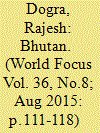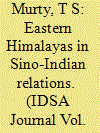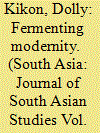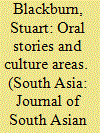|
|
|
Sort Order |
|
|
|
Items / Page
|
|
|
|
|
|
|
| Srl | Item |
| 1 |
ID:
139883


|
|
|
|
|
| Summary/Abstract |
Bhutan is a landlocked country sandwiched between India and the Tibet region of China in the eastern Himalayas. It covers an area of 46,500 sq. Kms, Roughly 150 km North to South and 300 km East to West. The kingdom is bordered by the Tibet region of China and the Indian states of Sikkim, West Bengal, Assam and Arunachal Pradesh. Geographically, Bhutan can be divided into four environmental zones: the Great Himalaya, the Inner Himalaya, the Outermost ranges and the Duars Plain.
|
|
|
|
|
|
|
|
|
|
|
|
|
|
|
|
| 2 |
ID:
177087


|
|
|
| 3 |
ID:
139471


|
|
|
|
|
| Summary/Abstract |
In this article, I explore notions of modernity, citizenship, belonging and transgressions in South Asia through the fermented food, akhuni. Fermented soya beans, popularly known as akhuni in Nagaland, a state in Northeast India with a majority tribal population, has a distinct pungent aroma and taste. This food is relished across the eastern Himalayan societies, including Nagaland, but routinely causes conflict between akhuni consumers and those who find the smell revolting. In 2007, due to increasing akhuni conflict in New Delhi, the Delhi police produced a handbook t hat cautions students and workers from Northeast India and eastern Himalayan societies that they should refrain from cooking akhuni and other fermented foods. Such official directives reiterate how the state plays a significant role in legitimising or prohibiting certain foods that particular social groups in contemporary India consume, relegating these communities to a remote position in the national social and culinary order. Against the backdrop of such friction, this article examines why akhuni consumers of the eastern Himalayan societies assert that eating fermented food is an integral part of their culture and history. Conversations about eating cultures, I argue, have to be understood as expressions of resistance, negotiation and the anxieties of striving to be a modern tribal in contemporary India.
|
|
|
|
|
|
|
|
|
|
|
|
|
|
|
|
| 4 |
ID:
080566


|
|
|
|
|
| Publication |
2007.
|
| Summary/Abstract |
This essay explores the possibility of defining a culture area by the comparative study of oral stories. Although neither the culture area concept nor the comparative study of oral traditions is currently fashionable in anthropology or folklore studies, both were once at the centre of theoretical debates in these disciplines. At the least, the hypothesis in this paper is intended to draw attention to the explanatory potential of both this concept and this methodology.
The data presented in the essay comes both from the author's fieldwork on oral stories and rituals in Arunachal Pradesh, India, and from similar collections made in neighbouring regions. Based on this evidence (primarily three separate oral stories and one ritual event), the essay suggests that we can consider the 'extended eastern Himalayas' as a culture area. This proposed culture area consists of three regions: central Arunachal Pradesh, the Myanmar (Burma)/India/Bangladesh border, and upland Southeast Asia/Southwest China. Adapting the model of vertical descent from historical linguistics, the argument is that the shared stories derive from a common oral tradition among Tibeto-Burman speakers. Horizontal borrowing across populations is not ruled out, but this model is usually best suited to explain commonalities in material culture. For similarities in verbal culture, such as the common oral stories in the extended eastern Himalayas, vertical borrowing down generations is a more convincing explanation
|
|
|
|
|
|
|
|
|
|
|
|
|
|
|
|
|
|
|
|
|